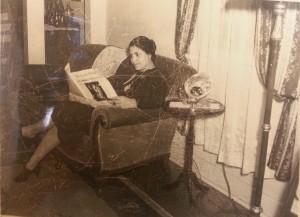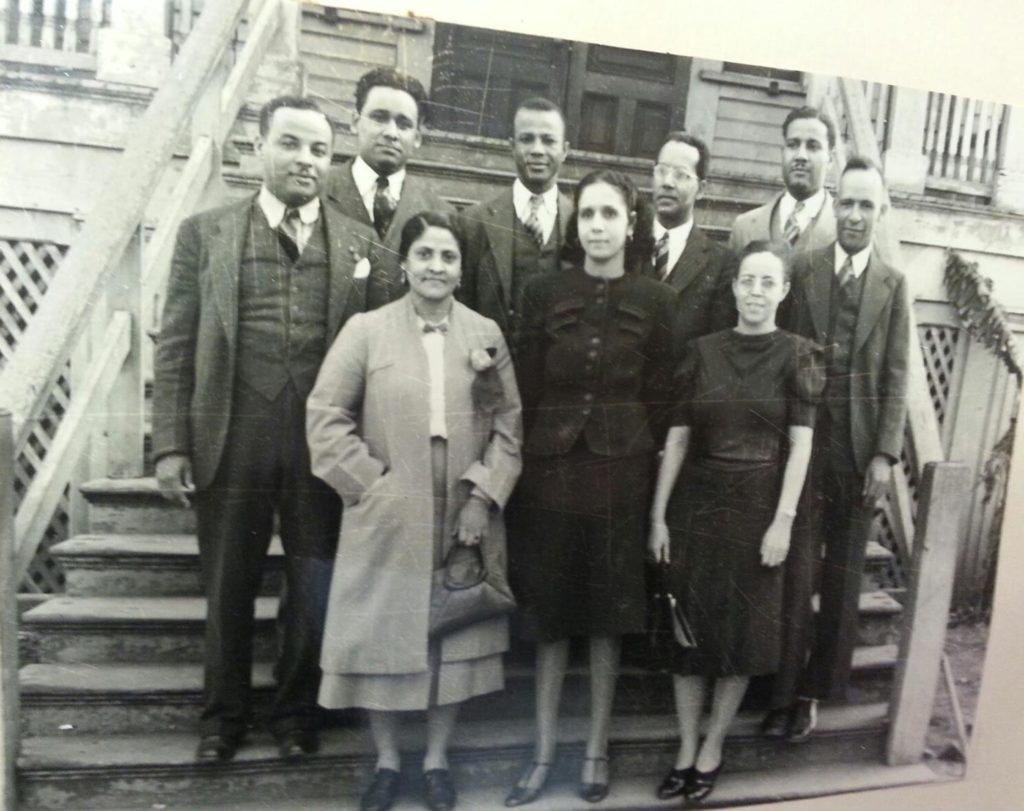Edna Cordier relaxing at home (1921)
At the turn of the 21st century when most young women of color were home raising families, Edna Cordier was in the trenches organizing a union for public school teachers, educating students and actively participating in community activities in New Orleans.
Edna was one of six children born to Leon and Mathilda Dutillet Cordier on 27 January 1897. She and her siblings (Leon Jr., Cecilia, Mary, Clifton and James) were raised in a Catholic home in the 7th ward of New Orleans. They resided at 1439 North Prieur. After the death of her father in 1917, Edna would continue to reside with her mother and several siblings in the family home located at 918 North Roman and later at 930 Laharpe Street.
Miss Cordier attended Straight Elementary and High School where she earned a teaching certificate. In 1932 she earned a Bachelor of Arts degree and a Master’s degree in 1941 from Xavier University.
At an early age, Edna Cordier developed a keen interest in sports, especially tennis. In the 1920s, she held the women’s tennis championship title and was credited with victories over most of the best men players in the city. In August, 1926, the St. Katherine Tennis Club of New Orleans announced that Miss Edna Cordier and Mr. W. H. Mitchell would represent their organization in the national tournament to be held in St. Louis the following month.
Crescent City Style Show (1926)
In the photo above, Miss Cordier is pictured in The Louisiana Weekly in sports’ attire at the Crescent City Style Show where she received the title of “All- around Athletic Girl.” Three years earlier (in 1923) she was voted one of the most beautiful young women in New Orleans.
Edna Cordier became a classroom teacher in Orleans Parish, a position she would hold for the next forty-six years before retiring in 1964. During her career she taught in a total of six schools in both Algiers and New Orleans, spending her last teaching days at Rivers Frederick Jr. High.
Miss Cordier was an eye witness to the vast inequalities that existed in the educational system in New Orleans during her years as a classroom teacher. Not only were teachers of color paid less than their white counterparts with the same education and experiences, but their working conditions were much worse. They had larger number of students (50% more in some cases), and worked in dilapidated, unsafe buildings with inadequate supplies and hand- me-down textbooks once used by white students.
During the Depression of the 1930s, all teachers took massive pay cuts but the school board promised to restore their pay in 1937. That money was restored in 1937 but only to white teachers. Edna Cordier and Veronica B. Hill, along with a few other colleagues, demanded that the board live up to its promise that all teachers would be paid and not just white teachers. After the board refused to do so, these teachers organized a group known as the New Orleans League of Classroom Teachers, local # 527 of the AFT. Edna Cordier was elected its first president and in 1940 they filed a suit against the school board for equalization of pay. Four years later (1944) a court order demanded the school board to equalize all salaries.
Left to right: [First Row] Alvin Robinson, Edna Cordier, Thelma Robinson Collier, Marie Dejan, Maurice Martinez
[Second Row] Emmanuel Gregoire, George Stevens, Charles B. Rousseve, Maurice Prevost,
By 1947, Edna was elected financial secretary of the union and continued in this capacity until her retirement in 1964. The League continued to grow and within a mere six months was credited with bringing 74% of black teachers into the AFT. This was a greater percentage of the teaching force than the local white group of the AFT ever succeeded in organizing. The struggle was not an easy one since union members had to convince teachers that they would not lose their jobs if they joined and that professional people (such as teachers) needed the protection of labor unions. Edna Cordier and her colleagues were called “radicals” by many, but black teachers soon realized that they had little to lose and much to gain through association with a labor union. This organization later merged with the Orleans Educator’s Association to form the United Teachers of New Orleans.
Throughout her career, Edna was highly respected by her peers and actively involved in many community groups, including the NAACP Education Committee, Urban League of New Orleans, Xavier University Alumni Association, and the Catholic Commission on Human Rights. In 1964, she was honored by the Orleans Parish School Board for “A Lifetime Devoted to the Children and Future of New Orleans.”
Edna M. Cordier died on December 20, 1974 but the legacy she left behind as an educator and pioneer for teachers’ rights will long be remembered.
Sources: Footprints of Black Louisiana, Norman R. Smith, page 51; A Will of Her Own: Sarah Towles Reed and the Pursuit of Democracy in Southern Public Education, Sarah Towles Reed, page 103; Pittsburgh Courier, 7 April 1926 page15, The Louisiana Weekly, 1926 photo-Edna Cordier; The Times- Picayune (obituary) 22 Dec. 1974, page 12; Ancestry.com, census records 1910- 1920-1930-1940, photos from Xavier University Archives /Special Collection, Xavier Herald 1941.
Lolita V. Cherrie

![20151217_101634[1]](https://www.creolegen.org/wp-content/uploads/2015/12/20151217_1016341-e1621726066286-225x300.jpg)




I am constantly thanking you for all the memories and information you are bringing to all of us.
I remember Ms. Cordier well. In the picture above Emmanuel Gregoire – a cousin of mine; Maurice Martinez – longtime family friends for several generations along with others were true pioneers that made it possible for the rest of us to have a better education. It is great to read about Ms. Cordier. Hope others will contribute their knowledge of this history – it is one that we are going to lose if this generation does not put it together in writing someplace.
This article talked about Ms.Cordier’s tennis interest and that she and W.H. Mitchell represented New Orleans at a tennis match. It would be a great follow up to outline the history of tennis in New Orleans. My great-grandmother- Capitola Taylor- was a tennis buff and played often with her daughter, Olivia Taylor and others. William Mitchell is Sue Jane Smock’s father and was head of the YMCA on Dryades Street in New Orleans having come from Princeton, New Jersey. It is an area that was big among New Orleans Creoles as well as others and is also an area about which very little is recorded. Capitola Taylor played a generation before Edna Cordier. Who knew this was such an active area in New Orleans ! (Marceline Donalson)
Hi Marceline,
Thank you for your comments. You have such a wealth of information to share! While researching this article, I became very interested in the important role tennis played in the lives of our people in the early years of the 20th century. I have several yearbook photos of the tennis club at McDonogh# 35 during the 1930s which were taught by Belfield Spriggins. The Y also contributed a great deal under the leadership of William Mitchell. If anyone has further info in this area, please comment here or send an email to Lolitac454@aol.com. I would love to do further research on this topic. Thanks….Lolita
Ms. Cordier taught me at Valena C.Jones Schoo;.